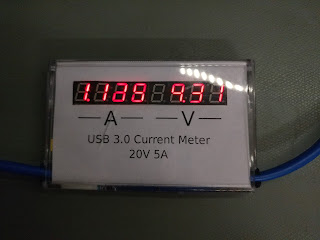 | |
| Completed project photo |
This project is a USB current meter based on the Cypress PSoC 5 microcontroller. The PSoC is an innovative microcontroller which combines a CPU with a small amount of programmable digital logic and some advanced analogue peripherals.
The objective was to implement it using as few external components as possible, by utilising the advanced peripherals built into the microcontroller. I also wanted it to support USB 3.0, because many USB power meters only support USB 2.0, meaning they cannot be used to measure the operating current of devices plugged into a USB 3.0 port - a typical use case is seeing if a phone increases its charge current to 900mA when plugged into a USB 3.0 port. Another objective was that the update speed needed to be fast, since many commercial meters have a very slow refresh rate. Additionally, it needed to support higher voltages than normal USB, so that it could be used to measure the voltage of "fast" chargers.
PSoC 5 microcontrollers are only available in surface-mount packages, so I've chosen the CY8CKIT-059 development kit so that I can build the circuit on stripboard.
To avoid potential signal integrity issues, I cut into a cable and just connected the power lines to the stripboard instead of adding my own USB connectors to the board. The current sensing is done using a 0.05-ohm resistor (the metal strip next to the cable) which is connected directly to two PSoC pins, and the voltage sensing is done using a normal potential divider connected to a third pin. The PSoC is powered from a 3.3V regulator in the TO92 package. Finally, the 7-segment displays are connected via current limiting resistors. The display is multiplexed to reduce the number of I/O required.
 |
| Top view of stripboard assembly |
 | |
| Bottom view of stripboard assembly |
The PSoC design is very simple. The peripherals are easily configured using a block diagram. The differential delta sigma ADC is used to measure the current. The input range and gain can be configured to allow even small voltages to be measured with good precision. The successive approximation ADC is used for the single-ended USB voltage measurement. Both ADCs can use internal voltage references, which should prevent the supply voltage from affecting the ADC readings.
In addition to the block diagram, the CPU needs some code to handle the remaining functions: responding to the ADC ISR, filtering the readings, and converting the readings into digits to display on the 7-segment displays. The LED Driver takes care of the display multiplexing, so there's no need to program a timer ISR for that.
The project met the goals, and it can accurately measure the current and voltage of a USB connection. The PSoC microcontroller enabled a high level of integration not normally possible with traditional microcontrollers, which would enable the PCB to be made much smaller should size be a design consideration.
It should be noted that the delta sigma ADC is only included on the higher-end PSoC chips, and that the lower-end chips have a lot less peripherals and programmable logic. The CY8CKIT-059 is a loss leader with the PSoC chip itself being more expensive, so you must trade off cost for convenience and board space when selecting the PSoC. You can now (2020) buy a USB 3.0 power meter for less than it would cost to build this PSoC-based meter, so the PSoC may not be the best choice for a product where cost is important. I do however think the PSoC is a great fit for low-volume high-margin products, with or without size constraints.





No comments:
Post a Comment